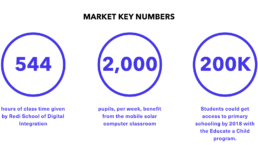Innovative e-learning products and services present opportunities not only to improve educational offerings in conflict-affected regions, but to support consolidation of peace through the delivery of skills and competencies. The ubiquity of the internet offers businesses the chance to reach out-of-school children.
Conflict and instability rob youth of the opportunity to receive an education, and an uneducated workforce can in turn further fuel instability in a region. More than 57 million children of primary school age are still out of school. 50 percent reside in conflict-affected areas. The use of e-learning technologies can have a remarkable and immediate impact on the education opportunities of formerly armed youth, returnees from refugee camps, migrants, and other post-conflict residents.
The internet is opening up an opportunity space for the private sector to completely change how education is delivered to children in conflict zones via various forms of online educational products. In doing so, the world would come a step closer to fulfilling the basic human right of education for all while granting children a sense of normality, familiar routine, and hope for the future.

Products and Services
Online learning products and services in this opportunity space come in a variety of forms. It is online programs enabling students to access lectures and well-stocked libraries via a smartphone. The best coursework on offer – in mathematics, science, foreign languages, and literature – can be uploaded to a mobile phone, tablet, or laptop and used by a students and teachers.
Educational games with child-centred design can be applied in conflict zones. Studies show educational games can be as effective as traditional learning tools in delivering educational outcomes. Games can provide immediate feedback to children on their results through video or visual elements and it can be a fun way to learn in difficult times.
In places where students and schoolchildren do not have access to smartphones, SMS-based solutions are part of this space. It can be using SMS quizzes in relation to curricula, or it can be the use of SMS to connect students and teachers in an area. Products in this opportunity space also include joyful and self-empowered learning via connected laptops; children are engaged in their own education, and learn, share, and create together. The One Laptop per Child initiative, an example of an initiative set up to enable this type of transformation of how education is delivered, also applies to children in conflict zones.
Rapid and continuous technological change leads to the constant evolution of products and services in this opportunity space. One of the trends is increasingly personalised educational programs via the ability of technology to tailor learning activities to a student’s individual learning needs and style.
Market Size and Demand Drivers
By 2020, global spending on education is expected to double to 8 trillion USD. Learning through mobile devices may make up as much as 70 billion USD of this market through specialised product offerings.
A demand driver in this opportunity space is the increasing penetration of mobile phones into rural areas and unstable regions and countries. In addition, aid agencies are increasingly calling on the private sector to develop solutions to deliver education to children in situations of conflict via partnerships, which is a source of demand.
Survey Findings
Unlike other market opportunities responding to the risk of unstable regions, the leaders in the survey have expressed a high level of confidence in the impact of using technology to promote remote learning in conflict regions, as well as in the current capacity to develop it.

Regionally, respondents in India rate this very positively, while leaders in China and Europe are more skeptical. Looking at the market opportunity through a gender lens, men show greater support for this opportunity than women.
Leaders believe the capacity is substantial enough globally to drive this market opportunity. The economic and political capacities to pursue this market are particularly strong.

Leaders across the globe see a good business case in engaging in this market relative to many of the other opportunities.
Leaders in the manufacturing sector look most positively at the benefits of this market to their sector. Respondents believe civil society and politicians can be expected to advocate strongest for this opportunity.
In India, where the opportunity is most popular, leaders believe the financial and government sectors will advocate strongly for it.
This market was surveyed globally in 2016 by more than 5500 leaders from both the public and private sectors. The survey was conducted in collaboration with the research company YouGov. The survey results were originally published in the Global Opportunity Report 2017.

